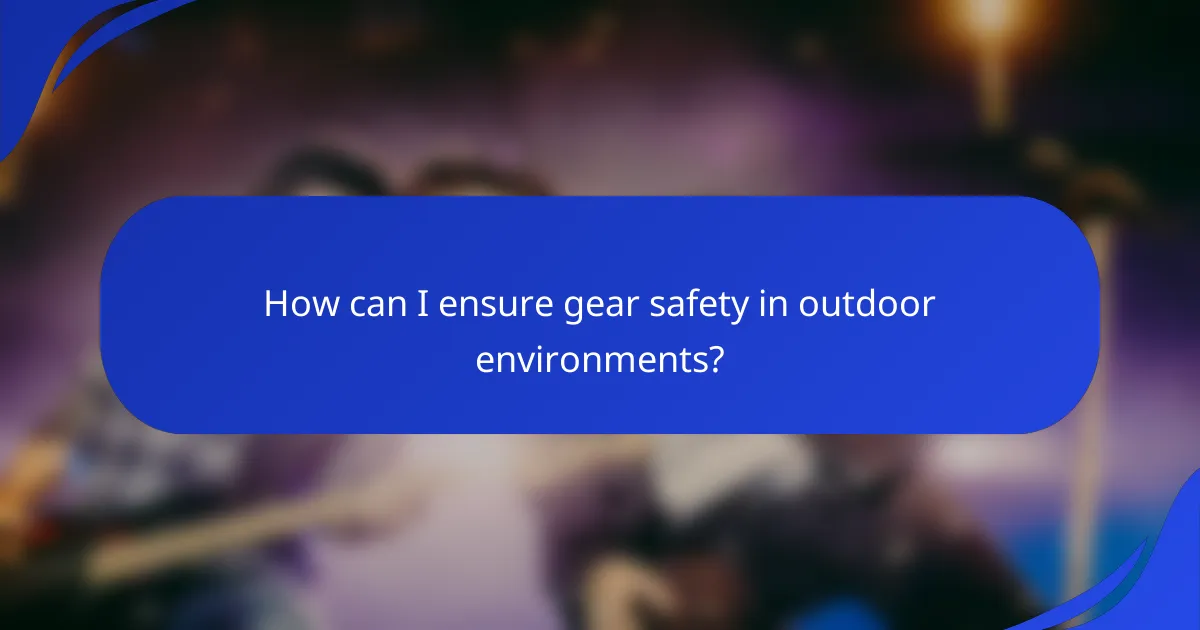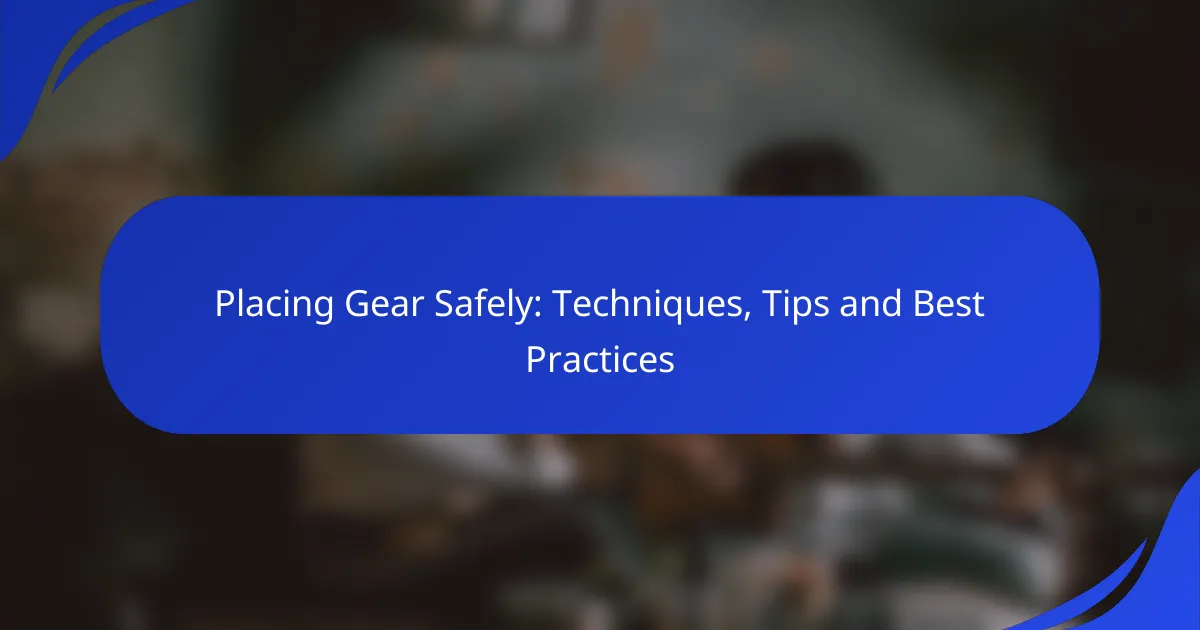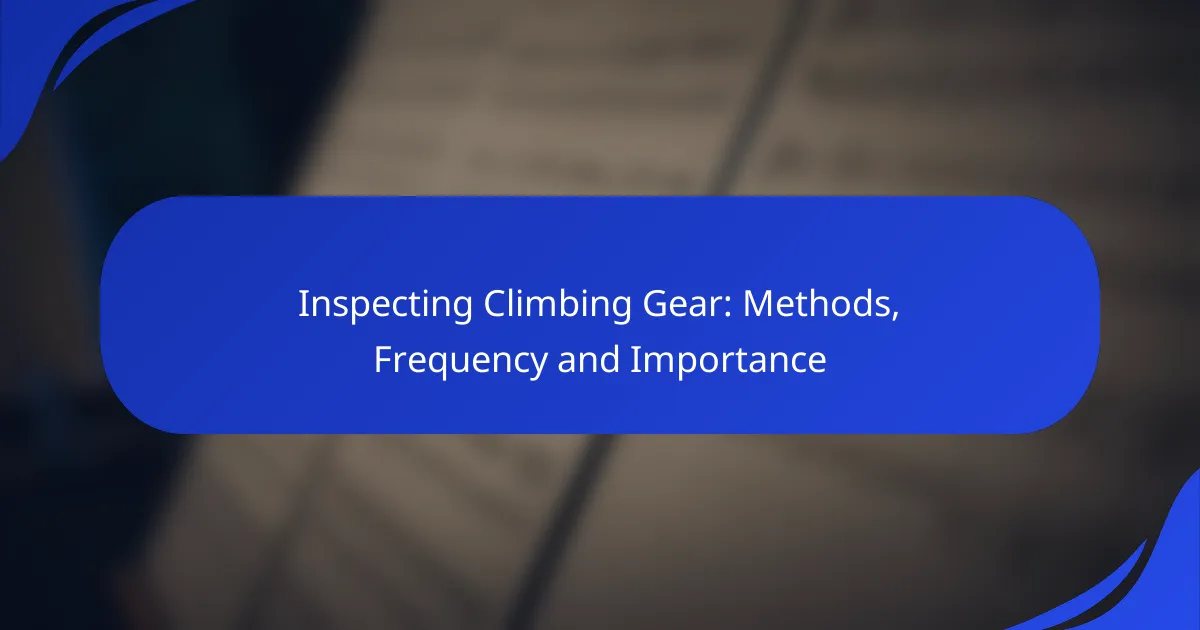Placing gear safely is essential for both user safety and equipment longevity. By focusing on proper weight distribution, secure fastening, and environmental awareness, you can prevent accidents and ensure that your gear remains stable and accessible. Additionally, prioritizing stable surfaces and implementing regular checks will further enhance safety and efficiency in outdoor settings.

What are the best techniques for placing gear safely?
To place gear safely, focus on proper weight distribution, secure fastening, and environmental awareness. These techniques help prevent accidents and ensure that equipment remains stable and accessible during use.
Weight distribution methods
Effective weight distribution is crucial for maintaining balance and stability. When placing gear, distribute weight evenly across the surface or support structure to avoid tipping or sliding. For example, when stacking items, place heavier objects at the bottom and lighter ones on top.
Consider using triangular or pyramid shapes for stacking, as these formations provide better stability. Always assess the load’s center of gravity and adjust the placement accordingly to minimize the risk of toppling.
Secure fastening techniques
Using secure fastening techniques is essential for keeping gear in place. Employ straps, ropes, or bungee cords to tie down equipment, ensuring they are tight enough to prevent movement but not so tight that they cause damage.
Regularly check fastenings for wear and tear, and replace any frayed or damaged components immediately. Utilizing locking mechanisms or safety clips can further enhance security, especially in high-risk environments.
Environmental considerations
Environmental factors can significantly impact the safety of gear placement. Be mindful of weather conditions, such as wind or rain, which can affect stability. For instance, avoid placing gear on loose or unstable ground, as this can lead to shifting or collapse.
Additionally, consider temperature extremes that may affect materials. For example, certain plastics can become brittle in cold weather, while heat can weaken some metals. Always choose appropriate locations based on the surrounding environment.
Using protective gear
Using protective gear is vital for safeguarding both equipment and personnel. Employ tarps, covers, or cases to shield gear from environmental damage, such as moisture or UV exposure. This is particularly important for sensitive equipment like electronics or climbing gear.
Additionally, personal protective equipment (PPE) should be worn when handling heavy or hazardous items. This includes gloves, helmets, and steel-toed boots to prevent injuries during placement or retrieval.
Proper storage solutions
Implementing proper storage solutions ensures that gear is organized and easily accessible. Use shelves, racks, or bins to keep equipment off the ground and away from potential hazards. Clearly label storage areas to facilitate quick identification and retrieval.
Consider the use of modular storage systems that can be adjusted based on changing needs. Regularly audit storage practices to eliminate clutter and ensure that all gear is stored safely and securely, reducing the risk of accidents.

How can I ensure gear safety in outdoor environments?
To ensure gear safety in outdoor environments, prioritize stable surfaces, assess weather conditions, and implement wildlife safety measures. These practices help prevent accidents and protect both your equipment and the surrounding ecosystem.
Choosing stable surfaces
Selecting stable surfaces is crucial for securing your gear. Look for flat, solid ground free from loose rocks or debris. Avoid areas prone to erosion or flooding, as these can compromise the stability of your setup.
When possible, use established campsites or designated areas that are designed to minimize environmental impact. This not only enhances safety but also helps preserve natural habitats.
Weather impact assessments
Before setting up gear, conduct a weather impact assessment to gauge potential risks. Check forecasts for wind, rain, and temperature changes that could affect your equipment’s safety. Sudden weather shifts can lead to hazardous conditions.
Consider using weather-resistant gear and securing items against strong winds or heavy precipitation. Always have a plan for quick evacuation if conditions worsen unexpectedly.
Wildlife safety precautions
Implementing wildlife safety precautions is essential to protect both your gear and local fauna. Store food and scented items in bear-proof containers or hang them at least 10 feet off the ground and 4 feet from tree trunks to deter animals.
Be aware of local wildlife regulations and guidelines, which may vary by region. Educating yourself about the animals in the area can help you take appropriate measures to avoid encounters and ensure a safe outdoor experience.

What are the recommended tips for gear placement?
To ensure safe and efficient gear placement, focus on regular checks, using specific storage solutions, and maintaining clear labeling and organization. These practices help prevent accidents and extend the lifespan of your equipment.
Regular equipment checks
Conducting regular equipment checks is essential for identifying wear and tear before it leads to failure. Schedule inspections at least monthly, or more frequently if the gear is used heavily. Look for signs of damage, such as frayed straps or rusted components.
During these checks, ensure that all gear is functioning correctly and is stored properly. Replace any damaged items immediately to maintain safety standards and operational efficiency.
Using gear-specific storage
Using gear-specific storage solutions can significantly enhance the safety and accessibility of your equipment. Invest in storage options designed for particular types of gear, such as padded bags for delicate items or waterproof containers for outdoor equipment.
Organize storage areas by grouping similar items together, which makes it easier to locate gear quickly. This method also helps prevent damage from improper stacking or exposure to environmental elements.
Labeling and organization
Effective labeling and organization of gear can streamline operations and reduce the risk of misplaced items. Use clear, durable labels that indicate the contents and any specific handling instructions. Consider color-coding for quick identification.
Maintain an inventory list that matches your labeled storage. This practice allows for easy tracking of equipment and ensures that everything is accounted for, minimizing the chances of loss or misplacement during use.

How do I select the right gear for safety?
Selecting the right gear for safety involves understanding the specific requirements of your activity and ensuring that the equipment meets relevant safety standards. Prioritize gear that is durable, well-reviewed, and suited to your environment to minimize risks.
Evaluating gear specifications
When evaluating gear specifications, focus on the materials used, weight limits, and safety ratings. Look for certifications from recognized organizations, such as ANSI or ISO, which indicate compliance with safety standards.
Consider the intended use of the gear. For example, climbing harnesses should support specific weight ranges and withstand dynamic forces. Always check the manufacturer’s guidelines for maximum load capacities.
Brand reliability assessments
Assessing brand reliability involves researching customer reviews and expert opinions. Brands with a long history in safety gear often have proven track records, which can provide peace of mind.
Check for warranties and customer service responsiveness. A reputable brand typically offers solid support and replacement policies, which can be crucial if issues arise with the gear.
Compatibility with other equipment
Ensure that your selected gear is compatible with other equipment you plan to use. For instance, if you are using a harness, verify that it fits well with your belay device and helmet.
Consider the interoperability of gear systems, such as communication devices or safety lines. Mismatched equipment can lead to dangerous situations, so always test compatibility before heading out.

What are the common mistakes in gear placement?
Common mistakes in gear placement can lead to accidents or equipment damage. Key errors include ignoring weight limits, neglecting environmental factors, and improper stacking of gear.
Ignoring weight limits
Exceeding weight limits is a frequent mistake that can compromise safety and equipment integrity. Always check the manufacturer’s specifications for maximum load capacities, which can vary significantly between different types of gear.
For example, climbing gear often has specific weight ratings, and exceeding these can lead to failure. A good rule of thumb is to stay within 70-80% of the stated limit to account for dynamic forces during use.
Neglecting environmental factors
Environmental conditions can greatly affect gear placement, yet they are often overlooked. Factors such as temperature, humidity, and terrain can impact the performance and safety of gear.
For instance, placing gear on wet or unstable ground can lead to slips or falls. Always assess the surroundings and consider using protective measures like mats or stabilizers in adverse conditions.
Improper gear stacking
Improper stacking of gear can lead to instability and accidents. When stacking, ensure that heavier items are placed at the bottom to maintain a low center of gravity.
Additionally, avoid stacking gear too high, as this increases the risk of toppling. A practical tip is to limit stacks to a height that allows for easy access while ensuring stability, ideally no more than shoulder height.

How can I improve my gear placement practices?
Improving gear placement practices involves understanding the environment, using proper techniques, and being mindful of safety. Focus on selecting secure locations and utilizing appropriate gear to ensure stability and reliability during use.
Understanding the Environment
Before placing gear, assess the surrounding environment. Look for stable surfaces, avoid loose rocks, and consider weather conditions that may affect gear performance. Familiarize yourself with local regulations regarding gear placement, especially in protected areas.
Evaluate the terrain and identify potential hazards such as falling debris or unstable ground. This awareness helps in making informed decisions about where to place your gear for optimal safety and effectiveness.
Techniques for Secure Placement
Use techniques such as triangulation and redundancy to enhance gear placement security. Triangulation involves placing gear at angles to create a stable base, while redundancy ensures that if one piece fails, another can take its place.
Always test your placements before relying on them. Pull on gear to check its stability and make adjustments as needed. This practice can prevent accidents and ensure that your gear will perform as expected during critical moments.
Best Practices for Gear Maintenance
Regular maintenance of your gear is essential for safe placement. Inspect gear for wear and tear, and replace any damaged components promptly. Clean gear after use to prevent corrosion and ensure longevity.
Keep a checklist for gear maintenance that includes inspecting carabiners, ropes, and anchors. This proactive approach helps maintain gear integrity and enhances safety during placement and use.










